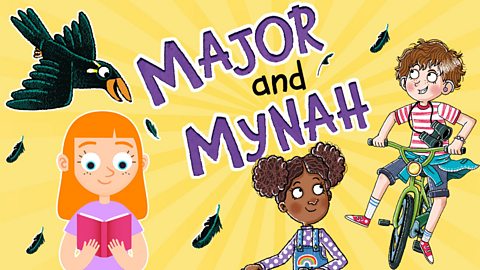What is the book about?
This guide is produced in partnership with Blue Peter.
Greenwild: The World Behind the Door, written by Pari Thomson and illustrated by Elisa Paganelli, is the seventh title in the Blue Peter Book Club.
Set in a magical world called the Greenwild, Daisy is on a quest to find her missing mother. With the help of some new friends, Daisy confronts a danger that could destroy her world and the Greenwild!
You can get a sneak peek of the book over on Blue Peter.
NARRATOR: Daisy Thistledown has a mystery to solve.
A search for her missing mother leads her across London, through a hidden doorway to another world that is bursting with magic.
The Greenwild.
Here she must confront a dangerous presence with the help of a botanical genius, a boy from another dimension and a cat with attitude.
Can she revive the Greenwild and find her missing mother?
What are fantasy and adventure stories?
Did you imagine the adventure that Greenwild took you on?
fantasyStories with imaginary worlds, people, creatures and events. stories take place in an imaginary world with people, creatures and events that you wouldn't find in the real world. Greenwild is an example of a fantasy story.

When Daisy leaves London ('the Greyside') and finds herself in 'the Greenwild', she has entered an imaginary world full of green-magic and natural wonders such as milk-chocolate trees, loyal bloodhounds and dream-like larder trees.
Greenwild is also an example of an adventure story.
Adventure stories often include:
- something exciting and extraordinary such as a quest or mission.
- escaping danger or experiencing something out of the ordinary.
Missions and out of the ordinary experiences are very common in Greenwild. One of Daisy's first missions is to find her mother, whilst experiencing the wonder, magic and marvel of a new world.
Learn how to write your own adventure story with this KS2 Bitesize English guide.

How are descriptions used to create imagery?
Did you notice whilst reading Greenwild you can constantly imagine a picture of the characters and what they're doing?
This is because of the author's use of descriptive language. Using descriptive language helps to draw vivid, clear images of the character and the settings in your mind. This is called imageryWhen descriptive language creates a clear image in the reader's mind..
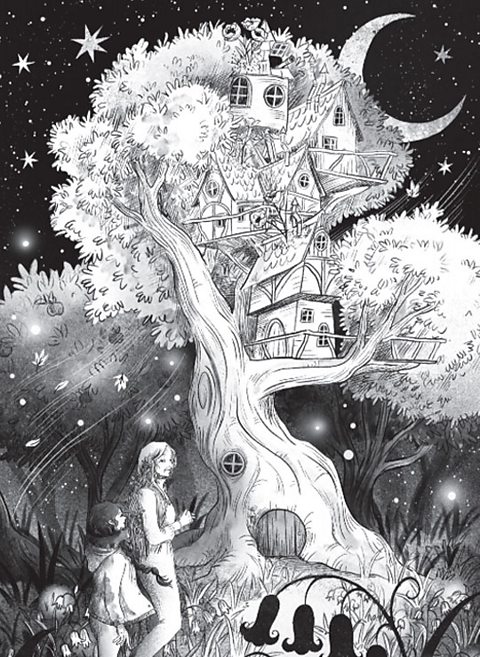
Pari Thomson (the author) uses well thought out adjectivesWords that describes a noun. to create this imagery.
There are lots of examples of character and setting descriptions in Greenwild.
For example, this description of Artemis White (page 76).
"Daisy noticed for the first time that the woman's emerald-green overalls were embroidered with a pattern of purple vines, and she was wearing high-heeled boots with sparkling buckles shaped like pomegranates. Her silver hair was looped with thorny winter roses."
Or this description of Chivvley Chase (page 96).
"It stood out at the end of a long avenue, looking like a cross between a large abbey and a small citadel, with sandstone walls the colour of honey and thick vines climbing up its many towers. There were magentas bell-flowers tumbling from the enormous arched windows, and energetic trees sprouting from the chimneys."

What is personification and how it is used in Greenwild?
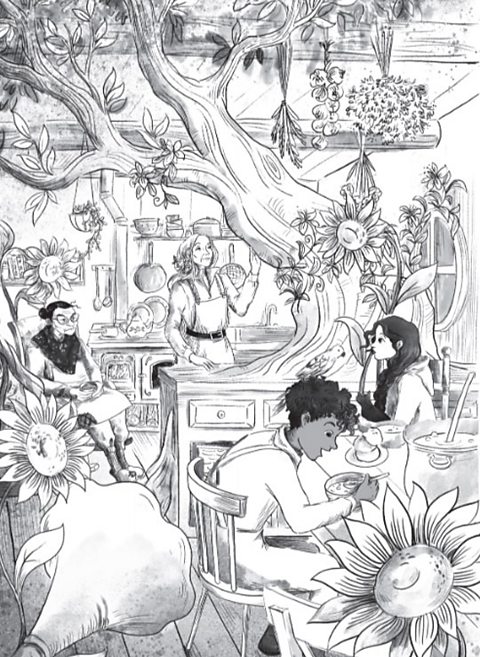
One descriptive tool that is used throughout Greenwild is personificationWhen objects are described as if they have feelings or can do actions like a person..
Personification is when you describe objects as if they have feelings or can carry out actions, like a person.
There are lots of examples in the book, such as:
"an enormous potted palm was waving its leaves in time to the music" (page 83).
Of course, plants can't really wave their leaves, however, this use of personification creates a clear image in your mind about the way the plant is moving.
"but it [the door] was waiting quietly for her in the crumbling stone wall" (page 147).
In real life, doors don't wait around for people to arrive because they aren't alive. This use of personification makes the door seem inviting and welcoming, as if it was there, just waiting for Daisy.
"Daisy's legs burned as she mounted the stairs." (page 301).
You'll know that your legs don't actually burn when you go up the stairs. But by using personification, the author makes it clear that Daisy's legs are hurting as she goes up the stairs - a bit like if they were burning!

Why are similes useful for describing characters, feelings and action?
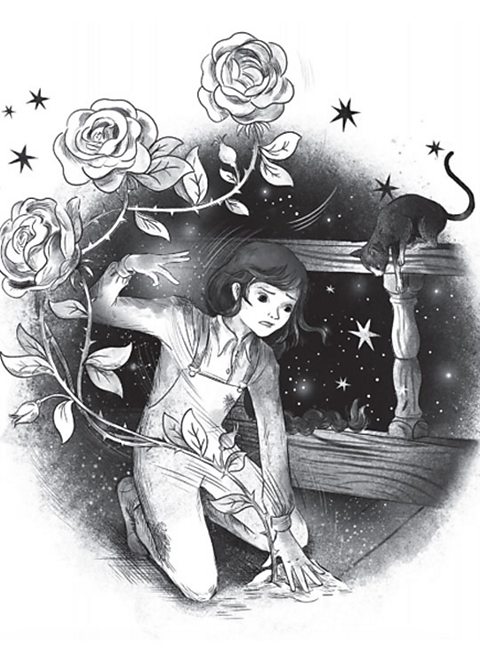
Greenwild is jam-packed full of descriptions.
SimileDescribing something by comparing it to something else using the word 'like' or 'as'. are a descriptive tool that the author has used to great effect throughout Greenwild.
A simile compares two things using the words 'like' or 'as'. They are a useful way to describe something without using a long list of adjectives.
As similes build images in your mind about a character's appearance, feelings and actions, you become more and more engaged in the story.
Similes have been used in Greenwild for an important reason; they are brilliant at creating a detailed image in your mind.
For example:
"The sandstorm arrived like a leopard on the hunt: fast and very wild." (page 1)
Not only does this simile create a clear image of a rapid leopard running, but it also explains what it means too: fast and wild!
"They were dandelions, with stalks as tall as trees and fat gossamer puffs as big as carousels." (page 77)
This makes it clear that the dandelions are gigantic!
"She'd spent her life feeling like a potted plant constantly being moved from place to place, never allowed to put down roots." (page 120)
This describes the unsettled feeling Daisy has when she is constantly moved from place to place.
"Daisy breathed in like a diver about to go underwater." (page 278)
It's clear that Daisy takes a deep breath in.

What is this simile trying to tell you?
"Spreading out from the landing stage was a city of boats on the water, lit with coloured lanterns and torches like fireflies."(page 307)
There are lots of small lights moving away from the landing stage, that looks similar to a group of tiny fireflies lit up at night.

Discover more about using similes with this KS2 Bitesize English guide.
Activity 1
Activity 2
Activity 3
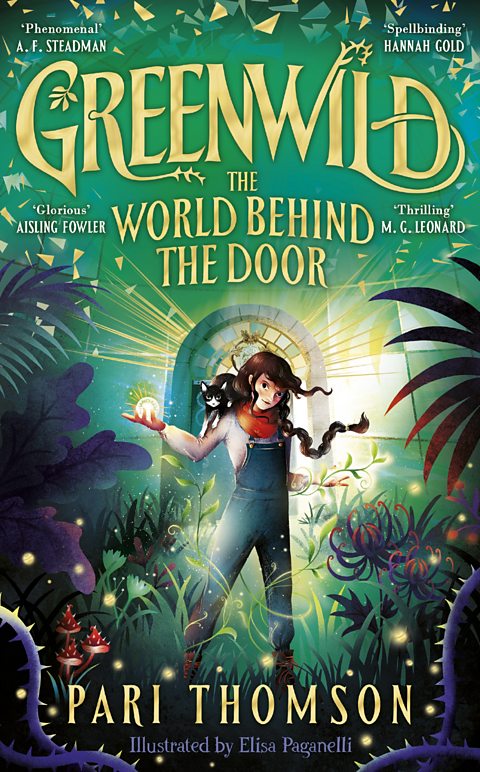
Using everything you've learned in this guide about Greenwild can you write a clear and exciting description for the front cover of the book?
Remember, you can include:
- adjectives
- similes
- personification
Using these descriptive tools will make your writing interesting to read, whilst creating a picture in the mind of the person reading your work.

More on Blue Peter Book Club
Find out more by working through a topic
- count9 of 13
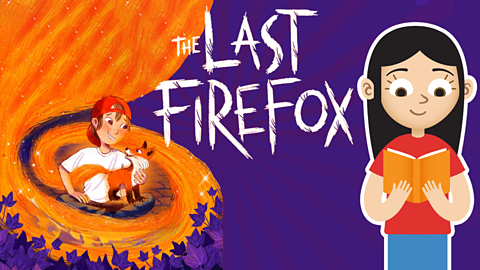
- count10 of 13
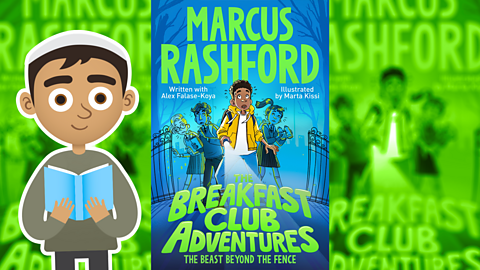
- count11 of 13

- count12 of 13
